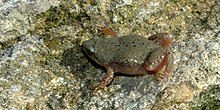| Gastrophryne | |
|---|---|

| |
| Gastrophryne carolinensis | |
|
Scientific classification
| |
| Domain: | Eukaryota |
| Kingdom: | Animalia |
| Phylum: | Chordata |
| Class: | Amphibia |
| Order: | Anura |
| Family: | Microhylidae |
| Subfamily: | Gastrophryninae |
| Genus: |
Gastrophryne Fitzinger, 1843 |
| Species | |
|
4, see text. | |
Gastrophryne, the narrowmouth toads (also American narrowmouth toads, North American narrow-mouthed toads), is a genus of microhylid frogs found in the Americas between Honduras and southern United States. [1] Its name means ‘belly-toad’, referring to its large belly, from the Ancient Greek gastēr ( γαστήρ, ‘belly, stomach’) and phrunē (φρύνη, ‘toad’). [2]
Gastrophryne is closely related to Hypopachus. Some species that were earlier placed in Gastrophryne were more closely related to Hypopachus, rendering the genus paraphyletic. [1] This has been rectified by moving some species ( Gastrophryne usta and Gastrophryne pictiventris) to Hypopachus. [3]
Gastrophryne frogs were the first species to be recognized to be experiencing speciation by reinforcement [4] and lead to the coining of the term reinforcement by W. Frank Blair in 1955; [5] a concept proposed by Theodosius Dobzhansky decades earlier. [6]
Species
The currently recognized species are: [1]
- Gastrophryne carolinensis (Holbrook, 1835) - eastern narrow-mouthed toad
- Gastrophryne elegans (Boulenger, 1882) - elegant narrow-mouthed toad
- Gastrophryne mazatlanensis (Taylor, 1943) - Mazatlan narrow-mouthed toad or Sinaloa narrow-mouthed toad
- Gastrophryne olivacea (Hallowell, 1856) - Great Plains narrow-mouthed toad

References
- ^ a b c Frost, Darrel R. (2014). "Gastrophryne Fitzinger, 1843". Amphibian Species of the World: an Online Reference. Version 6.0. American Museum of Natural History. Retrieved 22 March 2014.
- ^ Dodd, C. Kenneth (2013). Frogs of the United States and Canada. Vol. 1. The Johns Hopkins University Press. p. 20. ISBN 978-1-4214-0633-6.
- ^ Frost, Darrel R. (2014). "Hypopachus Keferstein, 1867". Amphibian Species of the World: an Online Reference. Version 6.0. American Museum of Natural History. Retrieved 22 March 2014.
- ^ Blair, W. F. (1955), "Mating call and stage of speciation in the Microhyla olivacea-M. carolinensis complex", Evolution, 9 (4): 469–480, doi: 10.2307/2405481, JSTOR 2405481
- ^ Sætre, Glenn-Peter. (2012). Reinforcement. eLS.
- ^ Jerry A. Coyne and H. Allen Orr (2004), Speciation, Sinauer Associates, pp. 353–381, ISBN 0-87893-091-4